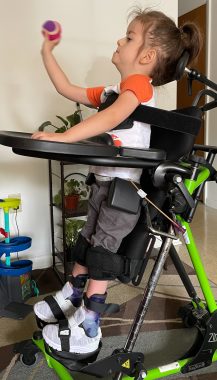Why I’m Donating My Son’s Used Adaptive Equipment
This columnist's son has outgrown his adaptive equipment, so Mom's giving back

Over the years, our family has become quite familiar with various types of medical and adaptive equipment. My 4-year-old son, Cayden, has used several medical and adaptive devices to help make his life with infantile-onset Pompe disease a bit easier. However, like any kid would, he eventually outgrows some of these things.
One piece of equipment that has been very helpful for our family is a standing aid, or stander. Cayden is unable to stand up or bear any weight on his legs due to his extremely low muscle tone, a common symptom for children with infantile-onset Pompe disease. The stander allows him to stand up for about 30 minutes at a time, or as long as he can tolerate it.

A stander assists Cayden during physical therapy sessions. (Photo by Keara Engle)
It feels good to help others
We got Cayden’s stander when he was about 18 months old, and it has lasted three years. But he has since grown taller and now needs a bigger one. The physical therapist that we see for his home-based therapy recently sent in the paperwork for a new one, but it will take some time to arrive at our home.
In the meantime, we will be giving his current stander to another little boy that Cayden’s physical therapist sees. The boy’s family tried to obtain a gait trainer for their son, but their insurance company denied the request. They really want their child to have the chance to stand up with assistance, and it feels so good to be able to help make that happen.
Another item we’ve used in the past — an eye gaze device — helped Cayden with communication. It works by using low-intensity lights to look into the user’s eyes, then tracks what they’re looking at on the screen, and audibly identifies it.
We have since moved on to an iPad for communication, and more recently, Cayden started using his voice and actually talking. After about a year of not using the eye gaze device, I decided it was time to pass it along to someone else who could use it. These devices are extremely expensive, and oftentimes insurance companies will put up a fight to avoid paying for them.
I made it my mission to find a new home for Cayden’s eye gaze device. With the help of his speech therapist, who had helped us obtain the device, we found a local place where we could donate it, called United Cerebral Palsy of Central Pennsylvania. They were happy to take the device off our hands and ensured us that a family would be thrilled to receive the donation.
This organization accepts all kinds of equipment to give to families in need, so I’ll keep it in mind as Cayden outgrows even more equipment.
Donating this medical equipment brings joy to my heart. I remember how grateful we were when we received these items for my son, and it helps me to know that I am able to pass them on to families who will appreciate them just as much as we did.
Note: Pompe Disease News is strictly a news and information website about the disease. It does not provide medical advice, diagnosis, or treatment. This content is not intended to be a substitute for professional medical advice, diagnosis, or treatment. Always seek the advice of your physician or other qualified health provider with any questions you may have regarding a medical condition. Never disregard professional medical advice or delay in seeking it because of something you have read on this website. The opinions expressed in this column are not those of Pompe Disease News or its parent company, BioNews, and are intended to spark discussion about issues pertaining to Pompe disease.








Comments
Maronita
Just as another resource often times state Rehabilitation Commission have established lists of adaptive equipment/medical devices that people want to give away to others that people who are looking for a variety of adaptive equipment/medical devices can check for or post. Also often local senior centers collect used medical equipment available to anyone in need regardless of age.